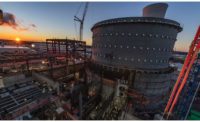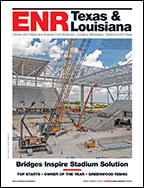This article originally appeared in ArchRecord.com.


The Miami City Commission is deliberating whether to give a nonprofit group the green light to rehabilitate Miami Marine Stadium, an abandoned Modernist landmark designed in 1963 by then 27-year-old Cuban-American architect Hilario Candela. The city, which has owned and operated the stadium since it opened, shuttered the facility in 1992 due to damage from Hurricane Andrew.
The nonprofit group Friends of Miami Marine Stadium (FMMS) has been working for years to revive the building. In addition to getting approval from city commissioners to renovate the structure, the group has secured The Heat Group to run the 6,566-seat stadium once it's restored—the result of a quiet outreach effort. The Heat Group operates the American Airlines Arena, where the Miami Heat play; company owner Micky Arison is managing general partner of the basketball team.
FMMS cofounder Don Worth says enlisting The Heat Group was a major coup. "We couldn't pretend our little volunteer group would run it," he explains. "We had a common vision for the stadium, and this is a perfect fit. They're a homegrown company with international reach and with all the infrastructure in place."
The stadium—originally built for powerboat racing—is located on the shore of the 860-acre barrier island Virginia Key in Biscayne Bay. The structure is made entirely of poured concrete and features a hyperbolic parabaloid roof that cantilevers dramatically toward the bay from eight columns. In June 2007, a master plan for Virginia Key recommended demolition of the stadium, spurring local preservationists to establish FMMS in February 2008. The following year the National Trust for Historic Places included the arena in its annual list of the "11 Most Endangered Places," and in 2010, the World Monuments Fund selected the building for its biyearly "Watch List."
The preservation efforts have paid off. In July 2010, Miami's city commissioners approved a new master plan for the island conceived by Candela and FMMS cofounder Jorge Hernandez, with help from students at the University of Miami School of Architecture. The stadium is the centerpiece of the redevelopment scheme. The movement to restore the venue got another boost last year when a local architecture competition organizer, Dawntown, unveiled the winners of an ideas competition to design a new floating stage for the arena.
FMMS has taken full responsibility for the building's resurrection. The decision facing the commission would give the group two years to develop a renovation plan, line up financing, and implement the plan. If successful, the group will then negotiate a long-term lease with municipal authorities. If unsuccessful, the city could decide not to grant the lease. Thanks to a county grant and tax credits for historic buildings, FMMS has already raised $12 million for the approximately $30 million project.
Worth believes the organization's passion helped get The Heat Group to sign on as its operating partner. "We've tried to position Marine Stadium as a Sydney Opera House type of property, something that symbolizes a city," he says. "The Heat understands the cachet."
Update 1/26/12: The Miami City Commission did not vote as planned on the Miami Marine Stadium during the Jan. 26 meeting. The issue was deferred to the commission’s February 9 meeting.

---Urban-Mining-Industries-Pozzotive_ENRready.jpg?height=200&t=1663257031&width=200)


Post a comment to this article
Report Abusive Comment